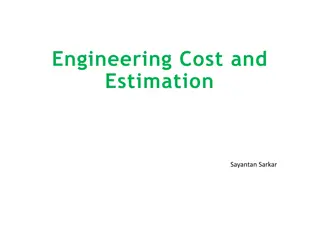Understanding Supply and Costs of Production in Economics
Supply in economics refers to the availability of goods and services in the market, influenced by factors like the law of supply, supply schedules, and supply elasticity. Cost of production involves considering marginal benefits and costs in determining output levels. These concepts are vital in understanding market dynamics and decision-making processes in economics.
Download Presentation

Please find below an Image/Link to download the presentation.
The content on the website is provided AS IS for your information and personal use only. It may not be sold, licensed, or shared on other websites without obtaining consent from the author. Download presentation by click this link. If you encounter any issues during the download, it is possible that the publisher has removed the file from their server.
E N D
Presentation Transcript
CHAPTER 5 Supply
UNDERSTANDING SUPPLY Supply is the amount of goods and services available.
UNDERSTANDING SUPPLY Law of Supply is the principle that suppliers will produce larger quantities of goods at higher prices. Ex. If a price of a good increases, firms will produce more to earn extra revenue and new firms will enter into the market.
UNDERSTANDING SUPPLY Supply schedule is a chart that lists how much of a good a individual supplier will offer at different prices.
UNDERSTANDING SUPPLY Supply curve- a graph that shows the quantity supplied of a good at different prices. The line always rises from left to right.
UNDERSTANDING SUPPLY Market supply schedule- a chart that lists how much of a good all suppliers will offer at different prices.
UNDERSTANDING SUPPLY Market supply curve- a graph of the quantity supplied of a good by all suppliers at different prices.
UNDERSTANDING SUPPLY Supply elasticity- is the measurement of the effect of price change on the amount of a product that a supplier makes. If a products price increases and supply increases quickly than it has elastic supply
UNDERSTANDING SUPPLY If production takes a long time to adjust to price increase, then product has a inelastic supply.
CHAPTER 5 Section 2
COST OF PRODUCTION Entrepreneurs need to consider marginal benefits and costs when deciding how much output to produce. Marginal product of labor is the change in output from hiring 1 more additional unit of labor. (How much more stuff is produced with additional employees.)
COST OF PRODUCTION As an entrepreneur invests in more labor, while keeping capital constant, the product of labor first increases then falls.
COST OF PRODUCTION Increasing marginal returns- marginal product of labor increases as the number of workers increase. (Output increase with more workers.) Diminishing marginal returns- a level of production where the marginal product of labor decreases as the number of workers increase. (Output decreases with more workers.)
COST OF PRODUCTION The most profitable level of output is where marginal revenue, the additional income from selling 1 more unit of a good is equal to marginal cost, the cost of producing 1 more unit of a good. Cost to make = price of product
CHAPTER 5 Section 3
CHANGES IN SUPPLY Several non- price factors can raise or lower the supply of a good at all prices, or cause it to shift to the left or right. 1. Input costs- when inputs (resources) become more expensive, supply falls and the supply curve shifts to the left. If inputs become cheaper, supply rises and shifts to the right.
CHANGES IN SUPPLY 2. Technology- new technology can lower the cost of production and increase supply, shifting curve to the right.
CHANGES IN SUPPLY 3. Government regulation- government encourages suppliers to produce more with subsidies or government money given to a business or market in order to increase supply. Government can also reduce supply with excise taxes, which is a tax on the production of a good. Ex. Cigarettes
CHANGES IN SUPPLY Other factors that affect supply are: worker productivity, price expectations, the number of suppliers in the market and competition from foreign suppliers. If sellers expect the price of goods they have to increase dramatically in the future, they will store the goods until the price rises

 undefined
undefined






















